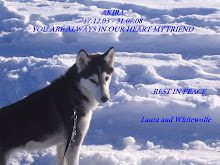
Ojibway Culture
Most Ojibwe lived in the northern Great Lakes
with a short growing season and poor soil.
They were hunter-gatherers who harvested wild rice
and maple sugar. Woodland Ojibwe had no salt to preserve food
and generally mixed everything with maple syrup as seasoning.
They were skilled hunters and trappers
(useful skills in war and the fur trade). Fishing,
especially for sturgeon, provided much of their diet
and became progressively more important in the northernmost bands.
As a rule, Woodland Ojibwe rarely used horses or hunted buffalo.
Dogs were the only domestic animal and a favorite dish
served at their feasts. The Ojibwe used birchbark
for almost everything: utensils, storage containers, and,
most importantly, canoes. Coming in a variety of sizes
depending on purpose, the birchbark canoe was lighter
than the dugouts used by the Dakota (Sioux)
and other tribes. Birchbark was also used to cover their elliptical,
dome-shaped wigwams. When a family moved,
the covering of the wigwam was rolled up and taken along
leaving only the framework.

(Birchbark Canoe)
Summer clothing was buckskin with fur outer garments added for winter.
The men wore breechcloths, but both sexes wore leggings.
Moccasins were the distinctive puffed seamed style
that gave Ojibwe their name. These were often colored with red,
yellow, blue, and green, dyes made by the women. Long,
cold winters were spent confined inside their wigwams
also allowed time to add intricate quill and moose-hair designs.
The Ojibwe often passed these times and entertained
each other with stories, an art for which they are still renown.
Generally, men and women wore their hair long and braided.
In times of war, men might change to a scalplock. Ojibwe scalped,
but as a rule they killed and did not torture.
Like other Great Lakes warriors, there was ritual cannibalism
of their dead enemies. Polygamy was rare.
Their social organization was based on approximately
15-20 patrilineal clans which extended across band lines
and provided their initial sense of tribal unity.

(Ojibway beads)
According to their tradition,
and from recordings in birch bark scrolls,
they came from the eastern areas of North America,
or Turtle Island, and from along the east coast.
According to the oral history, seven great miigis (radiant)
beings appeared to the peoples in the Waabanakiing
(Land of the Dawn, or Eastern Land) to teach the peoples
of the mide way of life. However, the one of the seven great miigis
beings was too spiritually powerful and killed the peoples
in the Waabanakiing whenever the people were in its presence.
The six great miigis beings remained to teach while
the one returned into the ocean. The six great miigis
beings then established doodem (clans)
for the peoples in the east.

(Turtle island)
Of these doodem, the five original Anishinaabe doodem
were the Wawaazisii (Bullhead), Baswenaazhi (Echo-maker, or Crane),
Aan'aawenh (Pintail Duck), Nooke (Tender, or Bear)
and Moozoonsii (Little Moose), then these six miigis
beings returned into the ocean as well.
If the seventh miigis being stayed,
it would have established the Thunderbird doodem.

(Crest of the Anishinaabe people)
Most Ojibwa, except for the Plains bands,
lived a sedentary lifestyle, engaging in fishing, hunting,
the farming of maize and squash, and the harvesting
of Manoomin (wild rice). Their typical dwelling
was the wiigiwaam (wigwam), built either as a waaginogaan (domed-lodge)
or as a nasawa'ogaan (pointed-lodge), made of birch bark,
juniper bark and willow saplings. They also developed
a form of pictorial writing used in religious rites
of the Midewiwin and recorded on birch bark scrolls
and possibly on rock. The sacred scrolls are complicated
with a lot of historical, geometrical, and mathematical
knowledge communicated through the many complex pictures.
The miigis shell (cowry shell) was also used in ceremonies,
and this shell can only be found from far away coastal areas,
indicating a vast trade network at some time across the continent.
The use and trade of copper across the continent
is also proof of a very large area of trading
that took place thousands of years ago,
as far back as the Hopewell culture.
Certain types of rock used for spear and arrow heads
were also traded over large distances. The use of petroforms,
petroglyphs, and pictographs was common throughout
their traditional territories. Petroforms
and medicine wheels were a way to teach
the important concepts of four directions,
astronomical observations about the seasons,
and as a memorizing tool for certain stories and beliefs.

(Ojibway wigwam)
The Ojibwe people and culture are alive and growing today.
During the summer months, the people attend jiingotamog
for the spiritual and niimi'idimaa for a social gathering (pow-wows)
at various reservations in the Anishinaabe-Aki (Anishinaabe Country).
Many people still follow the traditional ways of harvesting wild rice,
picking berries, hunting, making medicines, and making maple sugar.
Many of the Ojibwa take part in sun dance ceremonies
across the continent. The sacred scrolls are also kept
hidden away until those that are worthy
and respect them are given permission to see them
and then to interpret them properly.
The Ojibwa would bury their dead in a burial mound;
many erect a jiibegamig or a "spirit-house" over each mound.
Instead of a headstone with the deceased's name
inscribed upon it, a traditional burial mound would typically
have a wooden marker, inscribed with the deceased's doodem.
Due to the distinct features of these burials,
Ojibwa graves have been often looted by grave robbers.
In the United States, many Ojibwa communities safe-guard
their burial mounds through the enforcement
of the Native American Graves Protection and Repatriation Act.
Several Ojibwa bands in the United States cooperate
in the Great Lakes Indian Fish & Wildlife Commission,
which manages their treaty hunting and fishing rights
in the Lake Superior-Lake Michigan areas.
The commission follows the directives of U.S. agencies
to run several wilderness areas. Some Minnesota Ojibwa
tribal councils cooperate in the 1854 Authority,
which manages their treaty hunting
and fishing rights in the Arrowhead Region.
~Whitewolfe~
























No comments:
Post a Comment